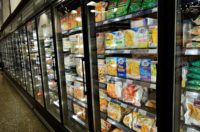The latest data from research firm IRI (Information Resources Inc.) and BCG (Boston Consulting Group) shows frozen and refrigerated food sales leveling off after a sharp sales spike in March due to COVID-19 stockpiling by consumers.
Metrics for the week ending March 29 show frozen food sales are still up +31.3% compared to last year, but that number dropped significantly from +78.8% in mid-March. Dairy sales also saw a decline, dropping to +20.9% from +57.8%. Dry/refrigerated yeast, and refrigerated canned ham are the only two perishable item to place in the top ten of all edible/non-edible products in terms of sales growth, at +282.3% and +130.0%, respectively, compared to last year.
A deeper dive into the current metrics show sales declines across the board for frozen items like:
- Frozen pizza = +52.4% (down from +117.2%)
- Ice cream = +28.8% (down from +33.5%)
- Frozen novelties = +14.7% (down from +31.6%)
Refrigerated items slowing in sales include:
- Uncooked meats, excluding poultry = +46.3% (down from +82.0%)
- Shredded cheese = +46.1% (down from +77.0%)
- Fresh eggs = +38.0% (down from +70.7%)
- Sliced lunchmeat = +21.4% (down from +78.1%)
- Whole milk = +15.4% (down from +47.2%)
- Skim milk = +8.8% (down from +46.7%)
Meanwhile, yogurt actually saw a year-over-year decline in sales, with -6.9% compared to this time last year, and +41.7% in mid-March. Also dropping from the mid-March numbers is frozen cookie dough, which didn't place at all in the current report, but was up a staggering +574% year-over-year a few weeks ago.
Overall, these are still impactful sales increases year-over-year, but it appears panic buying and hoarding of F&B by the public has settled down. Consumers are focusing more on buying/storing non-edible items like personal care products, and they're relying more on e-commerce and delivery as they settle into shelter-in-place lifestyles. For a complete overview of the current statistics, you can download the report here.
Click here for more COVID-19 coverage and how it is affecting the refrigerated and frozen foods industry.




